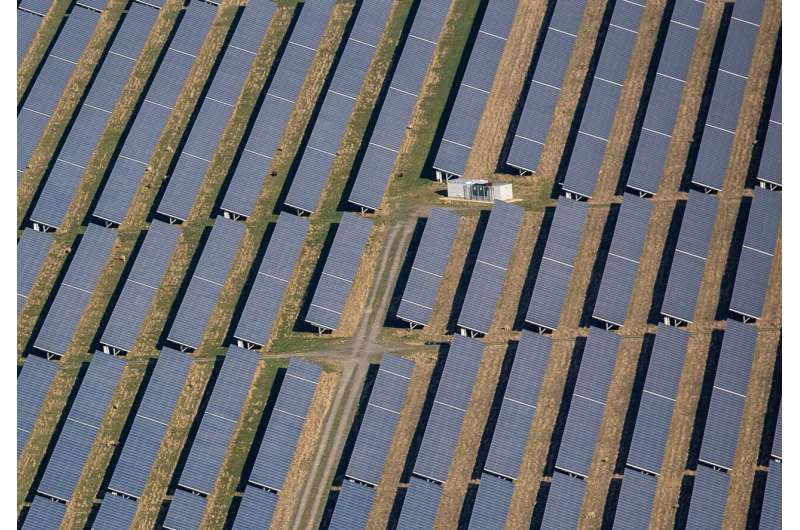
As the country ramps up its stock of solar farms in the West, rural Nevada is bracing for impact. Especially so in one of the state's most-strained water basins outside of Las Vegas.
Following the release of the Bureau of Land Management's updated Western Solar Plan, some in Nye County's Amargosa Desert wrapped in a bitter, ongoing fight with federal land managers and solar companies have decided to submit official protest letters expressing their concerns. The protest period closes at the end of this month before the plan becomes final.
The plan opens up about 12 million acres of land in Nevada for solar development, 220,000 of which lie in the watershed of the fickle Amargosa River, a largely underground water source that runs from Beatty into Badwater Basin at Death Valley National Park. Nevada's BLM office declined to comment on concerns brought up by the plan.
"It's going to be an industrial park," said Carolyn Allen, town board president of Amargosa Valley, a 900 square-mile rural town where solar farms could border homes and schools as currently proposed. "They are blanketing everything for solar."
The BLM has said it plans to develop 700,000 of the 31 million total acres into solar farms over the course of two decades in the 11 Western states. That's more than seven times the size of the city of Las Vegas.
Nevada's vast public lands are central to the country's goal of 100 percent reliance on clean energy by 2035—a priority that could change depending on who is in the White House.
Plenty of solar is likely to come to Nevada, which tops the list of states in the acreage available for projects and has dozens of projects already underway. The state's forthcoming construction of NV Energy's Greenlink transmission lines will make solar siting in rural areas easier, as projects must be within 15 miles of a transmission line to be able to transport energy to urban centers.
Basin 162's solar problem
Of the Silver State's 17 counties, Nye County has the most acres of federal land now eyed for solar, with more than 2 million acres designated, said Megan Labadie, the county's natural resources director. It is the biggest Nevada county by land—and far from being the least populated.
It's home to what many believe is the state's most over-appropriated water basin, meaning that the legal rights people have on paper to pump water far exceed the amount replenished every year through snowmelt, or perennial yield.
Patrick Donnelly, Great Basin director of the Center for Biological Diversity, said projects can take up to 1,000 acre-feet of water each to construct. The perennial yield of Pahrump's Basin 162 could easily be outpaced by the demands of dozens of large solar companies, he said.
"Where is this water going to come from?" Donnelly asked. "That question is really unanswered in the Western Solar Plan."
In addition to concerns for rural residents who rely on private groundwater wells for drinking water, the basin is connected to Ash Meadows National Wildlife Refuge, often called the jewel of Nevada's Mojave Desert.
Through what's known as a mineral withdrawal, environmental groups have been fighting to stave off lithium mining in the area to protect the refuge's many groundwater-dependent endangered species, including the famed Devils Hole pupfish.
Nye County's paneled future
Labadie, the natural resources director for Nye County, said she remains troubled by the lack of rural outreach in developing the plan. There are a litany of threats the plan presents to desert living in Nye County, from the value of homes going down to air quality issues to the loss of historical areas such as the Old Spanish Trail.
A large driver of the economy in these towns is recreational eco-tourism, Labadie said.
"People don't want to be driving through solar facilities," she said. "They want to be driving through untouched desert."
The Nye County Commission voted to extend its moratorium on solar development for another 90 days this week in an effort to slow down the permitting of some proposed projects. Nye County, in addition to environmental group the Amargosa Conservancy and a handful of town boards, will be submitting formal protests to the BLM.
Labadie said county officials have come to the conclusion that they don't have any wide-reaching authority to stifle solar development.
"Regardless of whether or not we want solar in our county, it's coming," she said. "We need to develop some sort of map showing where we would love to have solar, or at least accept it."
The Amargosa Conservancy drafted an online petition it encourages people to sign, which had more than 250 signatures as of Thursday afternoon. Instructions on submitting an official protest letter to the BLM can be found on the official page for the project at eplanning.blm.gov/eplanning-ui/project/2022371/570.
2024 Las Vegas Review-Journal. Distributed by Tribune Content Agency, LLC.
Citation: 'They are blanketing everything': Solar plan a threat to Nevada, officials say (2024, September 23) retrieved 23 September 2024 from https://techxplore.com/news/2024-09-blanketing-solar-threat-nevada.html
This document is subject to copyright. Apart from any fair dealing for the purpose of private study or research, no part may be reproduced without the written permission. The content is provided for information purposes only.
